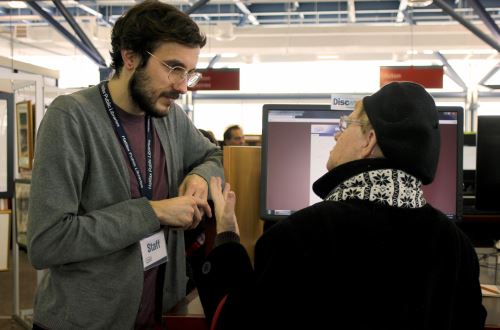Today I Bent a Rule
Barrier Identification Staff Survey at Halifax Public Libraries
 During a recent WebJunction webinar, Extreme Customer Service, Every Time, Sara Gillis shared in chat that their library had conducted a staff survey to help identify specific instances of barriers to customer service. Sara has written this article to explain this employee-driven approach to more responsive customer service.
During a recent WebJunction webinar, Extreme Customer Service, Every Time, Sara Gillis shared in chat that their library had conducted a staff survey to help identify specific instances of barriers to customer service. Sara has written this article to explain this employee-driven approach to more responsive customer service.
A session at the annual Ontario Library Association Super Conference presented by Markham Public Library (MPL) staff, called Evolution of the Revolution: Customer Service at MPL, resonated with us at Halifax Public Libraries. MPL had been grappling with issues around being a rules-based organization but at the same time wanting to refocus their policies, procedures, staff roles, training, and services to create a true customer focus. To help kick-start our own refocus on customer service we invited the MPL team to present to staff at Halifax Public Libraries and share their experiences on how MPL transformed their customer service approach through employee-driven initiatives.
Following the MPL presentations to our staff earlier this year, we asked staff for feedback on our own customer service strengths and weaknesses at Halifax Public Libraries through an online feedback form. Staff shared their thoughts on where they felt we excelled but also being very clear about what they felt we needed to work on. Many staff commented on the negativity in our messages to the public including this comment: "…at a minimum, we need to review our policies and ask 'why'. I like the notion of removing the negativity in our messages and empowering staff at all levels to make the customer service experience easy and pleasant" and another suggestion that we need to remove "…library created barriers to service - policy that ties people to following the rules over creating a good customer service experience".
A project we initiated right away was revamping our Public Use of Library Facilities policy – a lengthy list of prohibited behaviors that many felt indicated to our communities that the library was all about rules and barriers. Because we had also heard from staff that they wanted to be engaged and have a voice on regional initiatives, we formed a team that included staff from a variety of position classifications, representing a diversity of branches in our system. The new Use of Library Facilities policy created by this team has removed the negativity found in our former policy and highlights the desire to create safe and welcoming shared spaces. We will review the new policy in a year and get feedback from staff to see if it has met expectations.
 Because of the strong theme that emerged from staff feedback around barriers to service and that many of our rules and procedures often make it difficult for staff to provide the best service possible, we wanted to get a better grasp of the specific policies and procedures that staff felt were impeding customer service. Inspired by an article I had read in Public Libraries (Blaine Hilyard, (2010), p. 16) where a library system in Texas had staff record every time they told a customer "no ", we asked staff to identify specific instances of barriers to customer service they encountered over a period of several weeks.
Because of the strong theme that emerged from staff feedback around barriers to service and that many of our rules and procedures often make it difficult for staff to provide the best service possible, we wanted to get a better grasp of the specific policies and procedures that staff felt were impeding customer service. Inspired by an article I had read in Public Libraries (Blaine Hilyard, (2010), p. 16) where a library system in Texas had staff record every time they told a customer "no ", we asked staff to identify specific instances of barriers to customer service they encountered over a period of several weeks.
An online form was created on the library's Intranet and staff were provided with an opportunity to respond to the following statement:
Today I bent a rule (or wanted to) for the sake of providing good customer service.
Followed by three questions:
- What policy/procedure/rule does this pertain to? (Example: Circulation - renewals)
- If you know the specific Policy or Procedure include it here: (Example: Renewals at Circulation - 5401-01-08)
- Describe in more detail what the situation was and how you handled it, or how you wished you could have handled it:
Example: A customer returned their two books today and asked to renew them. I explained they had renewed the items the maximum number of times allowed and that they had to be shelved before being able to be borrowed again. They were panicked – they were relying on these items to complete a term paper that was due in 2 days and needed the books immediately. I looked the items up in Horizon and saw that we had another copy of one of the books on the shelf at the branch. The other item was an only copy. I checked with the Lead Hand and we decided to check them in and allow the customer to borrow both items again.
We indicated this could be expanded to include policies, rules, and processes that they found difficult to even explain to customers.
We received almost 100 responses and heard back about a variety of barriers, including circulation policies and procedures, computer access issues, and even the fact that we often do not offer "seamless service " through our practice of referring customers to other service desks. Several circulation related barriers have been addressed in an in-depth Circulation Operations Review (which began even before our barrier identification survey), but we now have clear idea of the work that remains to be done. Reviewing and revising policies in alignment with customer service needs has been included in our 2014/15 goal and objectives.
In addition to identifying specific barriers, the added bonus of involving all staff in these surveys was the staff engagement piece. Front-line staff have great insights and ideas, and a strong desire to collaborate in order to improve the customer experience.
References:
Blaine Hilyard, N. (2010) The Not-So-Secret Keys to Great Customer Service, Public Libraries, 49(5), 13-21.
Sara Gillis
Community-Led Service Manager
Halifax Public Libraries
www.halifaxpubliclibraries.ca
email: [email protected]
